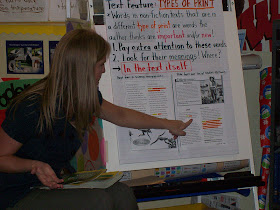*Attention Parents: Here is a link to the Land and Climate Poster Project students have due on Wed., Oct. 19!*
----------------------------
Our first unit in Social Studies is coming to a close. Students' Land & Climate Posters are due on Wed., Oct. 19. This week we are preparing for our Land & Climate test next Wed., Oct. 26. Today students cut cards for a vocabulary memory game they can play alone, with a friend, or with a family member. There are 21 words students need to know so I split up the words into two groups. There is a 'Yellow Game' in which students use the gold and light yellow cards, and there is a 'Purple Game' where students use only the dark purple and light purple cards. There is a pink answer sheet students can use to check their answers when they play either colored game.

During read aloud today, we read Owl Moon as a mentor text for sentence fluency. We learned that good writers start their sentences in a variety of ways. To help us see this, I had a student highlight the first word of every sentence from a 'fourth-grade' piece of writing, and then had her highlight the first word of a page from Owl Moon.
Students highlighted the first word of each of their sentences in a story they were writing. Some students discovered they started sentences in a variety of ways while others discovered they used words like "Then", "I", and "He" too much!
During reading, we reviewed what we learned last week about informational and everyday text. Authors use different types of print to make words stand out in a text.
When we notice a word in a non-fiction text that is written with a different type of print, it is important to pay attention to the word and find out what it means. There are a few strategies we can use to find the definitions of words that are in a different type of print. One strategy is to look within the text itself! We looked at a few examples from a science magazine and our social studies text book and found several examples of definitions that were immediately after the bolded word in the text.
We also discussed the importance of looking in the margins (which I don't have a picture of!), and then we discussed that words in a different type of print can often be found in the glossary in the back of the book. A glossary is another non-fiction text feature.
For guided practice, students looked through a leveled National Geographic magazine for bolded words. Their goal was to see what strategy helped them find the definition of the bolded word. Was the definition in the text itself, in the margin, or in the glossary at the end of the article?
Students shared out their findings. Some students read on and found the definitions of some of their words within the text itself. Others found their definitions in the glossary at the end of the article.
Homework:
1. Reading - 15 mins., Pizza Log
2. Math - 10 mins., 7.3: Front side only
3. Spelling - Test Fri.
4. Social Studies - Poster due Wed.












sorry i missed school yesterday looks like i missed allot of fun
ReplyDeleteFrom:Ana
Do you not do a question of the day anymore?
ReplyDeleteAna - I'm glad you're back!
ReplyDeleteMartina - I don't, but I should! Especially if I know you're going to visit! :) I miss you!
I love the smartboard comparison of a 4th grader's "anchor paper" using the same beginning of sentences then using a mentor text to compare. Do you have this link that you could perhaps send me! I am impressed with your structure & teaching! very engaging. My email is megkpetersen@yahoo.com
ReplyDeleteThanks-
Meg Petersen
Georgia
Hello! Love your web site. I love the engagement that I see in your pictures. Can you tell me if the sentence fluency mentor text and student's work activity was made on power point? My email is gabrimell@hotmail.com
ReplyDeleteHello, nice blog.
ReplyDelete